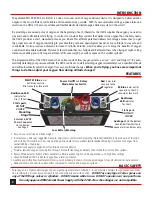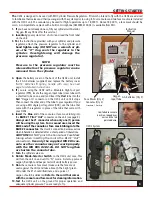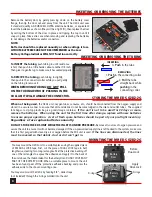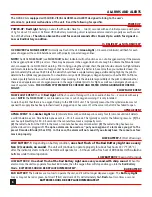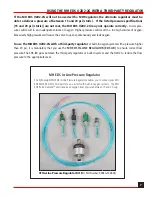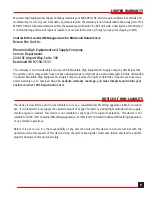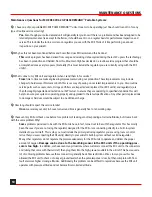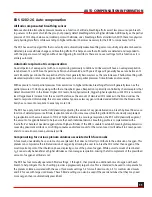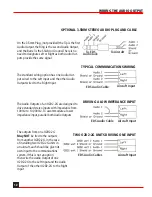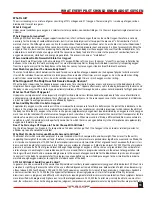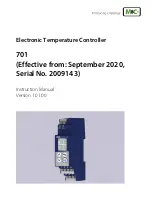
16
SPECIFICATIONS
The O2D2-2G Specifications, performance standards and limits are derived from actual units tested,
characterized or calculated. Specifications are subject to change without notice.
Allowable respiration rates:
Adaptive: from 40 bpm down to ~ 5 bpm (two persons independently)
Apnea time-out envelope:
Adaptive: ~32 sec at 0-11.5 K ft. pressure altitude, ~25 sec. at 13-18 K ft. pressure altitude,
20 sec. at and above 18 K ft. pressure altitude. Apnea alarm does not respond if in any of the ‘D’ modes and below that pressure
altitude threshold.
Operating inlet pressures:
15 psig (1 bar) Minimum DYNAMIC (flowing) through cannula and 1.5 meters (5 ft.) of 4 mm inlet
tubing. 25 psig (1.72 bar). Maximum static pressure.
Operating & storage temperatures, altitudes, vibration @ humidity, (assumes nominal operating voltage):
Temp range @ ~10% RH:
-40° to +60° C. (Storage for complete unit less battery)
Temp range @ ~25% RH:
0° to +60° C. (Operating with std. valve)
Temp range @ ~100% RH NC:
+5° to +60° C. (Operating with std. valve)
Unit is not water-proof, keep it
dry from spray & rain.
Altitudes @ up to ~100% RH:
-100 to +30 K ft. Pressure Altitude range @ +5° to +60° C. (Operating with std. valve)
Vibration:
Random vibration 5 to 500 Hz, (
15 minutes per axis @ 2.5 g. (rms) sin wave)
.
Physical characteristics (EDS-O2D2-2G unit only):
Width @ widest point: 4.3” (109 mm);
Height, including connectors: 3.85” (98.0 mm.);
Depth, front to rear: 1.25” (31.75 mm)
Weight: 12.1 Oz. (0.343 kg.) with batteries
Operating Voltage & Current @ 25° C. @ ~25% RH.
(Measured in the ‘N’ mode setting @ 15 bpm/ typical.)
:
Battery Types:
3 ea. Standard 1.5 volt alkaline type ‘AA’ or equivalent.
Battery Life:
50 Hrs. @ ~25° C. @ ~25% R.H. measured, assuming fresh alkaline-type batteries
operating under normal operating conditions.
Make certain quality alkaline-type batteries are used. Remove during long-term storage.
External Power:
4.5 VDC external power jack with auto battery disconnect with series diode is provided. No over-
voltage protection is provided.
External Audio Output:
3.5 mm stereo type jack provides audio output at ~40 mv. RMS into 5K
Ω
L&R independent.
Suitable for most aircraft Integrated Communication Systems (ICS).
Nominal Battery Voltage:
~4.25 VDC @ 4.30 ma. Idle. 220 ma. Peak (~500 ms. max), 3.25 ma. Average.
Min. Start-Up Voltage:
~2.80 VDC ± 0.1VDC.
Low Battery-1 Signal:
~3.3 VDC ± 0.1VDC. (Red light winking 1/sec.) ~4 Hours of service left.
Low Battery-2 Signal:
~3.0 VDC ± 0.1VDC. (Red light winking 1/sec. with chirp) ~1 Hour of service left.
Bad Battery Cut-Out:
< 2.5 VDC ± 0.1VDC. (Red light on steady, unit in non-responsive ‘dead’ state )
16
Width
Depth
Height
5MD20-0002-00$a 2015/11/01
NOTE: Use only
alkaline-type
batteries
NOTES:
The low battery cut-out feature provides a known state of action when the batteries get
depleted to the point of inadequate power to operate the unit to any of the declared specifications.
In addition, this feature was found to be prudent because, while many of the specifications may
stay intact, false-triggering of the valve may confuse the operator of a problem other than low
batteries. The minimum ‘start-up’ voltage is where the unit will initiate the built-in test and com-
mence operations. However, it should be noted that, during this operation, if the batteries are then
measured to be too low, the lock-up feature may then shortly ensue. This should help the operator
in determining if the unit is bad or if the batteries are too low. A unit that has low batteries that
cause ‘lock-up’ will most likely initially start-up if left off for some time. Alkaline-type batteries
have so-called self-rejuvenating properties that may cause the user to stall battery replacement.
Obviously, dead batteries will yield no action.
Batteries should be replaced at least once a year.

